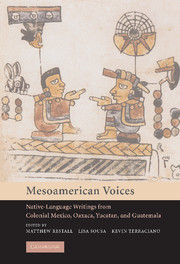Book contents
- Frontmatter
- Contents
- List of Documents and Images
- Preface and Acknowledgments
- Colonial Mesoamerica
- PART ONE
- PART TWO
- 3 Views of the Conquest
- 4 Political Life
- 5 Household and Land
- 6 Society and Gender
- 7 Crime and Punishment
- 8 Religious Life
- 9 Rhetoric and Moral Philosophy
- Glossary
- References and Readings
- Index
8 - Religious Life
Published online by Cambridge University Press: 05 October 2014
- Frontmatter
- Contents
- List of Documents and Images
- Preface and Acknowledgments
- Colonial Mesoamerica
- PART ONE
- PART TWO
- 3 Views of the Conquest
- 4 Political Life
- 5 Household and Land
- 6 Society and Gender
- 7 Crime and Punishment
- 8 Religious Life
- 9 Rhetoric and Moral Philosophy
- Glossary
- References and Readings
- Index
Summary
As the Spanish conquistadors swept through Mesoamerica, friars and priests quickly followed in their footsteps. Twelve members of the Franciscan order arrived in New Spain in 1524, and many more religious joined them in the following decades. They established parishes that were based squarely on native communities, and directed a part of native labor and tribute toward building the church and maintaining their conventos or religious establishments. The religious became involved in every enterprise possible in order to sustain their operations, from producing silk and sugar to selling African slaves. The orders (the most important being the Franciscans, Dominicans, Augustinians, and Jesuits) competed with one another for the best areas with the densest native populations. In the early period, the religious were among the only Spaniards living in the native countryside.
In the early post-Conquest period, members of the orders set out to find and destroy temples, images, and the native priesthood. They confiscated and burned codices (pictographic writings on deerskin or fig-bark paper) and created new sacred texts in the form of native-language doctrinas or catechisms. They sought to learn as much as possible about native beliefs and customs in order to identify and extirpate them. They underwent extensive native language-training programs so that they could communicate with people, preach to large audiences in the patios of the new churches, and hear confession.
- Type
- Chapter
- Information
- Mesoamerican VoicesNative Language Writings from Colonial Mexico, Yucatan, and Guatemala, pp. 174 - 201Publisher: Cambridge University PressPrint publication year: 2005

